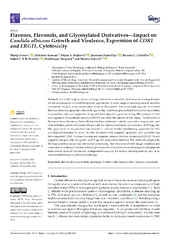Приказ основних података о документу
Flavones, Flavonols, and Glycosylated Derivatives—Impact on Candida albicans Growth and Virulence, Expression of CDR1 and ERG11, Cytotoxicity
| dc.creator | Ivanov, Marija | |
| dc.creator | Kannan, Abhilash | |
| dc.creator | Stojković, Dejan | |
| dc.creator | Glamočlija, Jasmina | |
| dc.creator | Calhelha, Ricardo C. | |
| dc.creator | Ferreira, Isabel C. F. R. | |
| dc.creator | Sanglard, Dominique | |
| dc.creator | Soković, Marina | |
| dc.date.accessioned | 2021-01-15T11:34:29Z | |
| dc.date.available | 2021-01-15T11:34:29Z | |
| dc.date.issued | 2021 | |
| dc.identifier.issn | 1424-8247 | |
| dc.identifier.uri | https://www.mdpi.com/1424-8247/14/1/27 | |
| dc.identifier.uri | https://radar.ibiss.bg.ac.rs/handle/123456789/4097 | |
| dc.description.abstract | Due to the high incidence of fungal infections worldwide, there is an increasing demand for the development of novel therapeutic approaches. A wide range of natural products has been extensively studied, with considerable focus on flavonoids. The antifungal capacity of selected flavones (luteolin, apigenin), flavonols (quercetin), and their glycosylated derivatives (quercitrin, isoquercitrin, rutin, and apigetrin) along with their impact on genes encoding efflux pumps (CDR1) and ergosterol biosynthesis enzyme (ERG11) has been the subject of this study. Cytotoxicity of flavonoids towards primary liver cells has also been addressed. Luteolin, quercitrin, isoquercitrin, and rutin inhibited growth of Candida albicans with the minimal inhibitory concentration of 37.5 µg/mL. The application of isoquercitrin has reduced C. albicans biofilm establishing capacities for 76%, and hyphal formation by yeast. In vitro treatment with apigenin, apigetrin, and quercitrin has downregulated CDR1. Contrary to rutin and apigenin, isoquercitrin has upregulated ERG11. Except apigetrin and quercitrin (90 µg/mL and 73 µg/mL, respectively inhibited 50% of the net cell growth), the examined flavonoids did not exhibit cytotoxicity. The reduction of both fungal virulence and expression of antifungal resistance-linked genes was the most pronounced for apigenin and apigetrin; these results indicate flavonoids’ indispensable capacity for further development as part of an anticandidal therapy or prevention strategy. | |
| dc.publisher | MDPI AG | |
| dc.relation | info:eu-repo/grantAgreement/MESTD/inst-2020/200007/RS// | |
| dc.relation | FEMS Research and Training Grant [FEMS-GO-2017-015] | |
| dc.relation | Fundação para a Ciência e a Tecnologia | |
| dc.relation | Foundation for Science and Technology | |
| dc.rights | openAccess | |
| dc.rights.uri | https://creativecommons.org/licenses/by/4.0/ | |
| dc.source | Pharmaceuticals | |
| dc.subject | Antifungal | |
| dc.subject | Antivirulence | |
| dc.subject | Biofilm | |
| dc.subject | Cytotoxicity | |
| dc.subject | Efflux pumps | |
| dc.subject | Flavonoids | |
| dc.subject | Isoquercitrin | |
| dc.title | Flavones, Flavonols, and Glycosylated Derivatives—Impact on Candida albicans Growth and Virulence, Expression of CDR1 and ERG11, Cytotoxicity | |
| dc.type | article | en |
| dc.rights.license | BY | |
| dcterms.abstract | Санглард, Доминиqуе; Соковић, Марина; Каннан, Aбхиласх; Стојковић, Дејан; Цалхелха, Рицардо Ц.; Ферреира, Исабел Ц. Ф. Р.; Иванов, Марија; Гламочлија, Јасмина; | |
| dc.rights.holder | © 2020 by the authors. Licensee MDPI, Basel, Switzerland. | |
| dc.citation.issue | 1 | |
| dc.citation.volume | 14 | |
| dc.identifier.doi | 10.3390/ph14010027 | |
| dc.identifier.pmid | 3396973 | |
| dc.identifier.scopus | 2-s2.0-85098846531 | |
| dc.identifier.wos | 000610683900001 | |
| dc.citation.apa | Ivanov, M., Kannan, A., Stojković, D. S., Glamočlija, J., Calhelha, R. C., Ferreira, I. C. F. R., et al. (2021). Flavones, Flavonols, and Glycosylated Derivatives—Impact on Candida albicans Growth and Virulence, Expression of CDR1 and ERG11, Cytotoxicity. Pharmaceuticals, 14(1), 27. | |
| dc.citation.vancouver | Ivanov M, Kannan A, Stojković DS, Glamočlija J, Calhelha RC, Ferreira ICFR, Sanglard D, Soković M. Flavones, Flavonols, and Glycosylated Derivatives—Impact on Candida albicans Growth and Virulence, Expression of CDR1 and ERG11, Cytotoxicity. Pharmaceuticals. 2021;14(1):27. | |
| dc.citation.spage | 27 | |
| dc.type.version | publishedVersion | |
| dc.identifier.fulltext | https://radar.ibiss.bg.ac.rs/bitstream/id/8056/pharmaceuticals-14-00027-v2.pdf | |
| dc.citation.rank | M21 |

